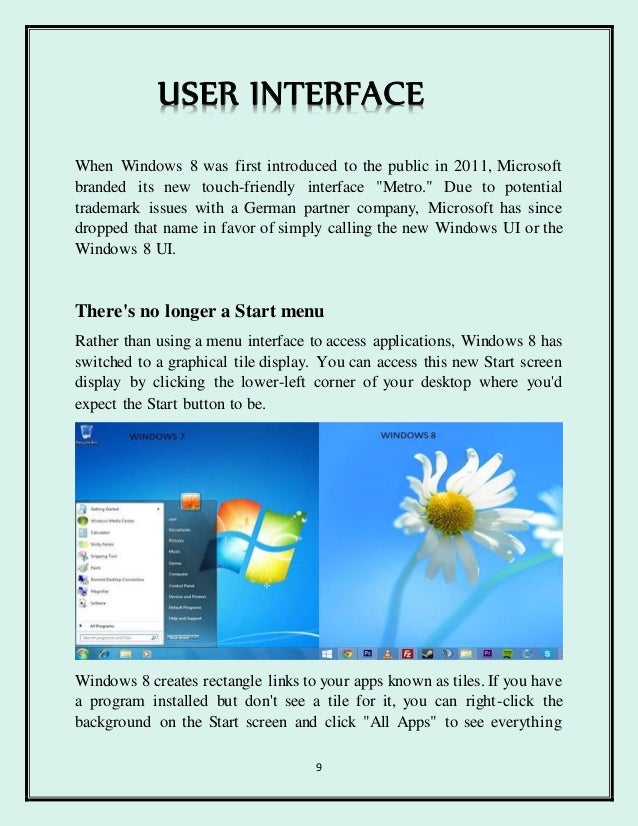Difference Between Windows 8 And Windows 7

Difference Between Windows 7 and Windows 8 – Windows 7 features. Windows 7 includes a number of new features when compared to Vista.
Some of them are touch and handwriting recognition, support for virtual hard disks, improved performance on multi-core processors, improved boot performance, kernel improvements.Windows 8 Features. 1)Windows 8 includes a new “Hybrid Boot” option that uses “advanced hibernation functionality” on shutdown to allow faster startup times. Another new feature is, the ability to create a Portable Workspace, an installation of Windows 8 on a USB storage device.Compare Windows 7 with Windows 8. Now we try to compare Windows 7 operating system with Windows 8 operating system. Surely, we can say in case of Boot time, there will be significant changes in the upcoming Windows 8 operating system compared to Windows 7. Better GUI will be there in Windows 8.
Windows came onto the market in 2012 and was meant to replace 7. The two operating systems have subtle differences which can change the way in which they are treated by programs such as. It is important to understand these differences when you buy any of the programs because it will affect how you configure them and how you use them.
Windows 8 Upgrade
The first difference is that when you log into Windows 8, the first review screen that you will is the “ Start Screen”. Another name for this screen is “ Metro”. The desktop is still the same as the other Windows packages.The user will no longer see icons but tiles. These then must be clicked in order to get access to the apps. Some people prefer to install and uninstall them on this screen, but you can do this through the apps manager as well. In cases where there is a tile that is missing, the user should right click on the mouse on the space that is found at the bottom of the screen. This will bring up a dialogue box with a drop down list which includes “ All Apps”.
Here you will be able to scan and view all the apps that are currently available on the system. If you are still missing one then you have to use your coupons in order to purchase it from the Windows store.Other important differences you must take note ofWhereas you are able to use programs and apps in Windows 8; the same facilities are not readily available in Windows 7. The former allows you to open a full screen on the metro. Here there is a similarity with Windows 7 where the programs would open on the desktop. Of course, this will not make a difference to the monitoring role of TotalSystemCare. In terms of the security arrangements, Windows 8 has come with a pre-installed antivirus program.
However, you are still at liberty to replace it with SafeBytes for additional security. Another new addition is that apps do not have to be closed by clicking on the X in the top right corner as was the case in Windows 7. Instead all that you are required to do is press the Windows key. This will return you to the start screen. In fact, some people use this method in order to escape the full screen that is often seen when working with the viewer.If you are thinking of buying Windows 8 it is important to take note of these facilities because they could potentially make your life very easy. For example, you can close an application by dragging it down from the top of the screen.
You use a mouse which clicks on the left button and then you hold down. Those that are using the touchscreen can use the screen as if it were a smartphone. A quick review of Windows 8 will show you that it does not have a start menu. Instead, you get a Charms Bar. This is the place where you go to when you want to shut down. It also has search facilities for scanning the entire system.
Hello, Could someone tell us what the differences between Windows 8 and Windows 10 about the display, fonts and GDI? Because we have developed some web applications. Since Windows 8 and Windows 10 are two recent operating systems developed by Microsoft, one should know the difference between Windows 8 and Windows 10 and the new features introduced before switching on to the new operating system. Windows 8 which is the successor of Windows 7 was officially released to the general public on October 26, 2012.